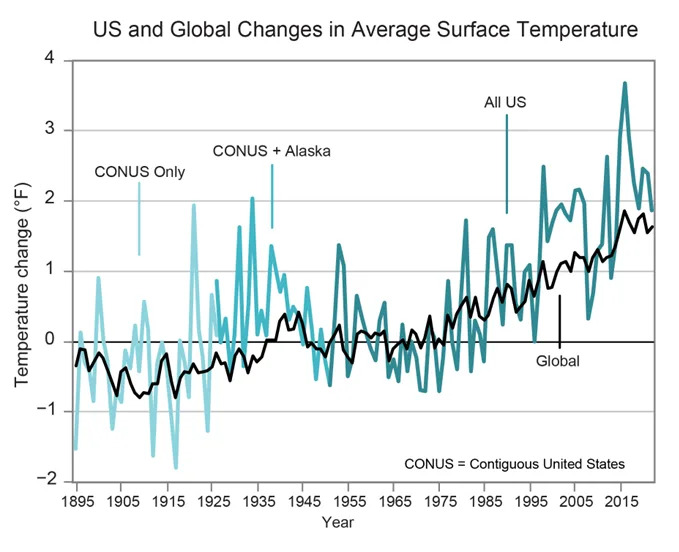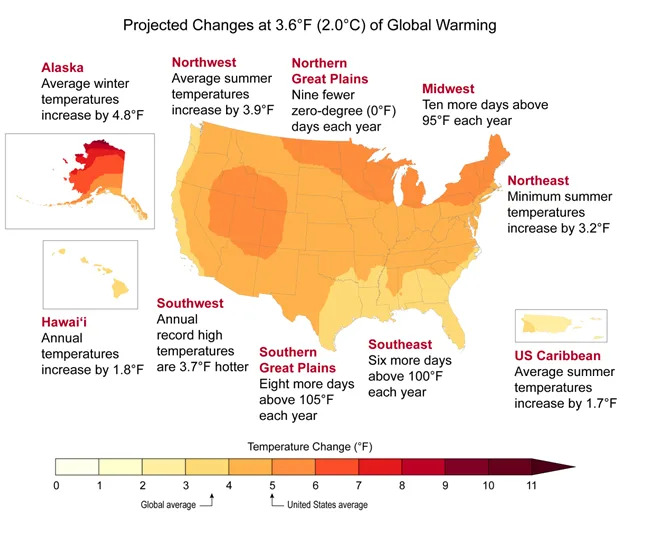USA Today
Who’s to blame for climate change? Scientists don’t hold back in new federal report.
Dinah Voyles Pulver and Doyle Rice – November 14, 2023 
Climate change is here and prompting unprecedented actions in every state to curb the greenhouse gas emissions fueling warming temperatures, but a new federal report out Tuesday says bigger, bolder steps are needed.
After several years of work by more than 500 authors from every state, Puerto Rico, the Virgin Islands, and Guam, the White House released the massive Fifth National Climate Assessment.
In remarks Tuesday morning, President Joe Biden announced more than $6 billion to bolster the electric grid, update water infrastructure, reduce flooding, and advance environmental justice.
“This assessment shows us in clear scientific terms, that climate change is impacting all regions, all sectors of the United States,” Biden said. “We’ve come to the point where it’s foolish for anyone to deny the impacts of climate change anymore.”
The assessment includes more evidence than ever before to demonstrate the cause and effects of the changing climate, said L. Ruby Leung, one of its authors. It also breaks from previous reports by saying unequivocally that humans are responsible for changes to Earth’s climate.
“It’s important for us to recognize that how much climate change we will be experiencing in the future depends on the choices that we make now,” said Leung, a climate scientist at the Pacific Northwest National Laboratory and lead author on the earth sciences chapter.
All of the impacts people are feeling, like sea level rise and extreme weather events, she said “are tied to the global warming level, to how warm the earth becomes,” Leung said. “And that depends very much on the level of CO2 concentration in the atmosphere.”
In other news, the United Nations released its latest analysis of national climate plans on Tuesday morning and found them “strikingly misaligned” with science. “The chasm between need and action is more menacing than ever,” said Secretary-General António Guterres. “It’s time for a climate ambition supernova in every country, city and sector.”

What is the 2023 National Climate Assessment?
The massive assessment describes the climate and economic impacts Americans will see if further action is not taken to address climate change. The report, issued roughly every four years, was mandated by Congress in the late 1980s and is meant as a reference for the president, Congress, and the public.
“Too many people still think of climate change as an issue that’s distanced from us in space or time or relevance,” said Katharine Hayhoe, an author of the report and chief scientist at The Nature Conservancy.
The assessment “clearly explains how climate change is affecting us here in the places where we live, both now and in the future and across every sector of human and natural society,” Hayhoe said. It also shows that “the risks matter and so do our choices.”
Climate Nexus, a nonprofit communications organization, said the new report is “essential reading,” because it highlights the seriousness of current impacts and shows the existing pace of adaptation isn’t enough to keep pace with future climate changes.
“Without deeper cuts in global net greenhouse gas emissions and accelerated adaptation efforts, severe climate risks to the United States will continue to grow,” the report states. “Each additional increment of warming is expected to lead to more damage and greater economic losses.”
However, greater reductions in carbon emissions could reduce the risks and impacts, and have immediate health and economic benefits, the report states.
Another heat record? Earth is historically and alarmingly hot. Now what?
What are the effects of climate change?
Millions are experiencing more extreme heat waves, with warmer temperatures and longer-lasting heat waves, the report states. It adds climate changes are apparent in every region of the country.
Among the noted effects:
◾ The number of nights with minimum low temperatures at or above 70 degrees has increased compared to 1901-1960 in every corner of the country except the northern Great Plains and Alaska.
◾ Average annual precipitation is increasing in most regions, except the Northwest, Southwest, and Hawaii.
◾ Heavier precipitation events are increasing everywhere except Hawaii and the Caribbean.
◾ Relative sea levels are increasing along much of the coast, except for Oregon, Washington, and Alaska.
◾ In the 1980s, the country experienced on average a $1 billion disaster every four months but now experiences one every three weeks. This year, the country has set a new record with 25 billion-dollar disasters.
Fishers and the warming climate Climb aboard four fishing boats with us to see how America’s warming waters are changing
Climate scientists around the world say 2023 is almost certain to be the globe’s warmest year in recorded human history. The global mean temperature through October was 1.4 Celsius (more than 2.5 degrees Fahrenheit) above the preindustrial average.
So far this year, the nation is experiencing its 11th warmest year on record through October, according to the National Oceanic and Atmospheric Administration. However, 12 states are experiencing their warmest or second warmest year on record.
Growing evidence that humans are changing the climate
This assessment is most notable for the certainty scientists have gained about warming and its impacts, said Leung, who served as the lead author for the report’s Earth Systems Processes chapter, which lays the scientific groundwork and is used to illustrate points throughout the report.
The chapter, a collaboration among more than a dozen authors, was intended to answer such questions as whether humans are causing global warming, whether warming is changing extreme weather and climate events and how much warming the planet might expect to see.
In prior reports, scientists often hedged their statements, for example saying they were 90% sure humans were responsible for the changes being seen,” Leung said. “In this NCA 5 report, we are now saying that we are totally sure.”
Starting from the 1900s, the observed warming has been caused by human activities, she said. “It’s definitive.”
Another key difference is scientists reduced by 50% the uncertainty in how much temperatures would warm if the concentration of carbon dioxide in the atmosphere doubles, she said. In previous assessments that number had hovered around a range from 2.7 degrees to 8 degrees. “It was a pretty big range,” she said. “Our goal has always been to narrow this down.”
Thanks to the increase in instrumental observations, satellite data, the study of the paleoclimate, and higher resolution computer modeling, scientists now have amassed more evidence than ever before, giving them more certainty, she said. “Now we can say that the global warming that is caused by a doubling of the CO2 in the atmosphere should be between 4.5 degrees Fahrenheit and 7.2 degrees Fahrenheit.”

Reducing greenhouse gas emissions
Efforts to adapt to climate change, reduce net greenhouse gas emissions, and be more energy efficient are underway in every U.S. region and have expanded since 2018, the report concludes.
Greenhouse gas emissions in the U.S. fell 12% between 2005 and 2019, mostly driven by changes in the way electricity is produced, the assessment concluded. The nation burns less coal, but more natural gas, which is cleaner. Because of the electrical industry’s 40% reduction in emissions, the transportation sector took the lead as the industry with the most emissions.
Growth in the capacity of wind, solar, and battery storage is supported by the falling costs of those technologies, and that ultimately means even more emissions reductions, the report states. For example, wind and solar energy costs have dropped 70% and 90%, respectively.
While the options for cleaner technologies and lower energy use have expanded, the authors found they aren’t happening fast enough for the nation to meet the goal of achieving a carbon-neutral energy system.
Without deeper cuts in global net greenhouse gas emissions and accelerated adaptation efforts, the scientists found severe climate risks to the United States will continue to grow. Each additional increment of warming is expected to lead to more damage and greater economic losses compared to previous increments of warming, and the risks of catastrophic consequences also increase.
But the report also finds that reducing greenhouse gas emissions and removing carbon dioxide from the atmosphere can limit future warming and associated increases in many risks, and bring immediate health and economic benefits.
What others are saying about the report:
The scientific assessment is “the latest in a series of alarm bells and illustrates that the changes we’re living through are unprecedented in human history,” said Kristina Dahl, a principal climate scientist at the Union of Concerned Scientists and a contributor to the report. “The science is irrefutable: we must swiftly reduce heat-trapping emissions and enact transformational climate adaptation policies in every region of the country to limit the stampede of devastating events and the toll each one takes on our lives and the economy.”
The report illustrates three things, said Arati Prabhakar, director of the White House Office of Science and Technology Policy.
◾ The events Americans have already experienced firsthand are “unfolding as predicted.”
◾ Communities in every state and territory have taken action.
◾ People across the nation can use the assessment to take future actions.
For example, Prabhakar said the report could be used by a water utility manager in Chicago trying to understand extreme rainfall, an urban planner deciding where to locate cooling centers in Texas, or a manager of a Southeastern hospital trying to get ahead of the diseases ticks and mosquitoes are bringing into their region as a result of the changing climate.













